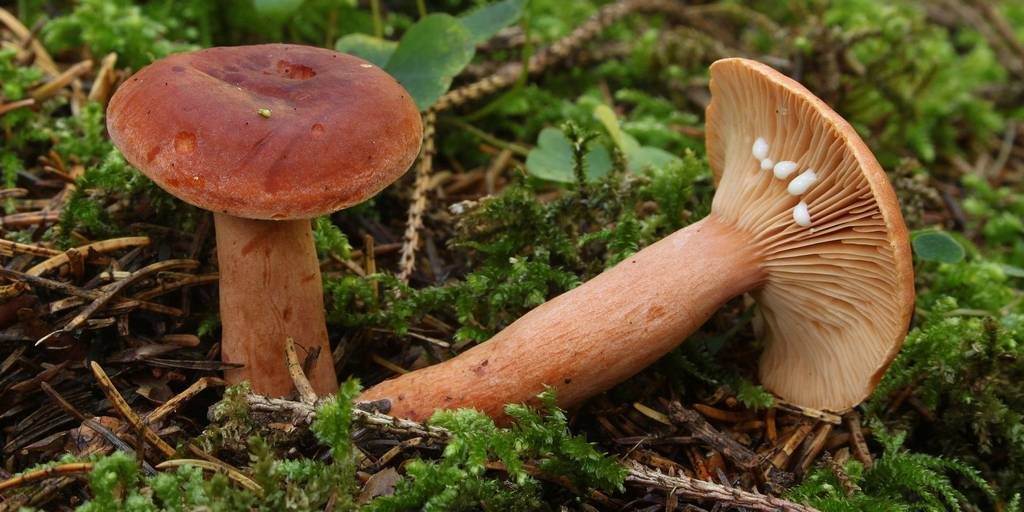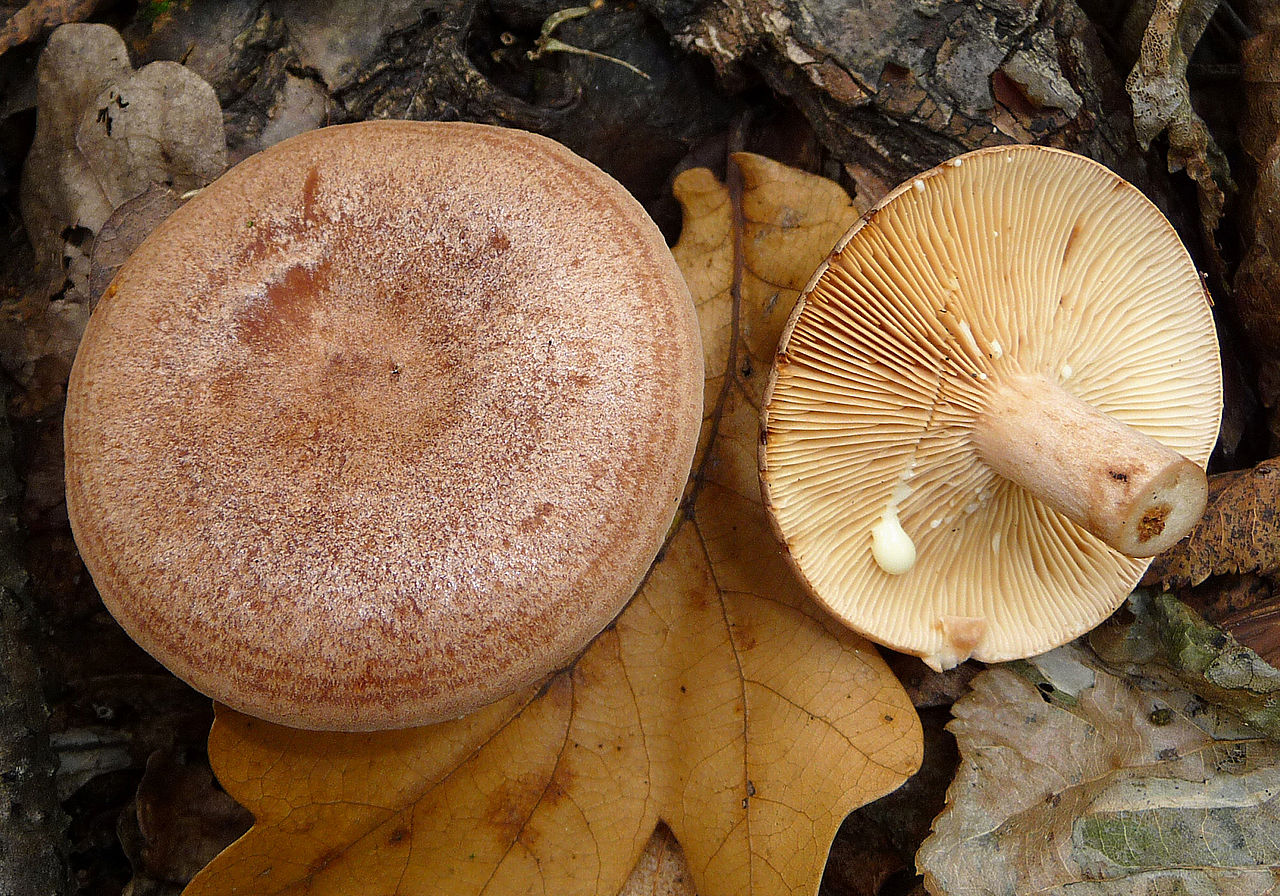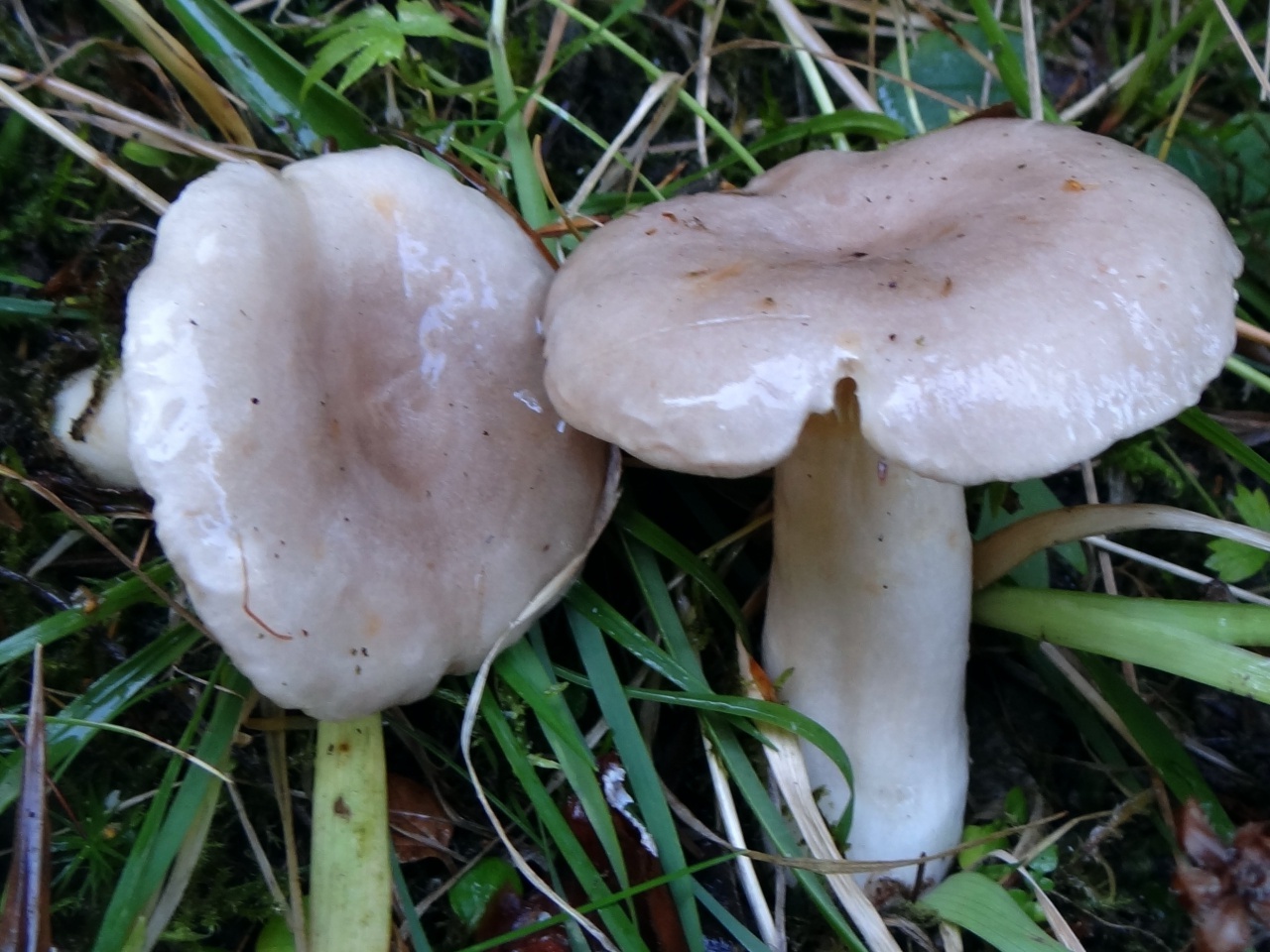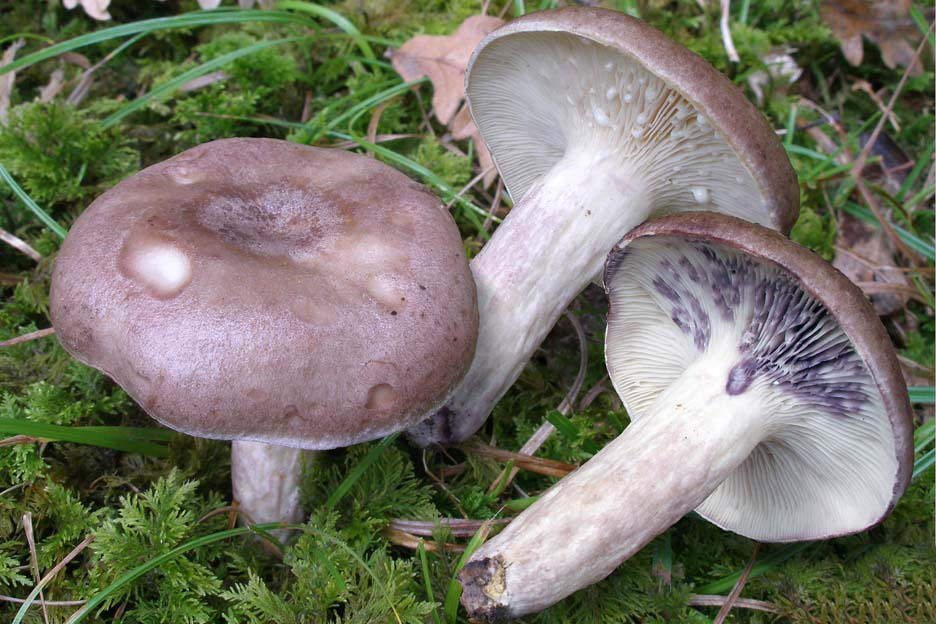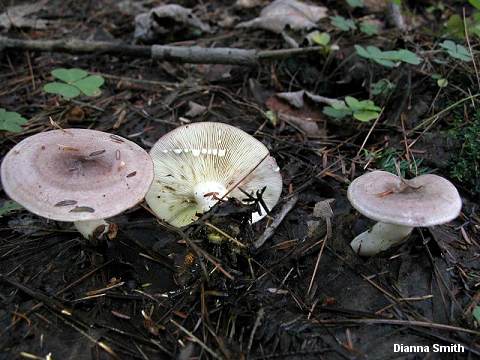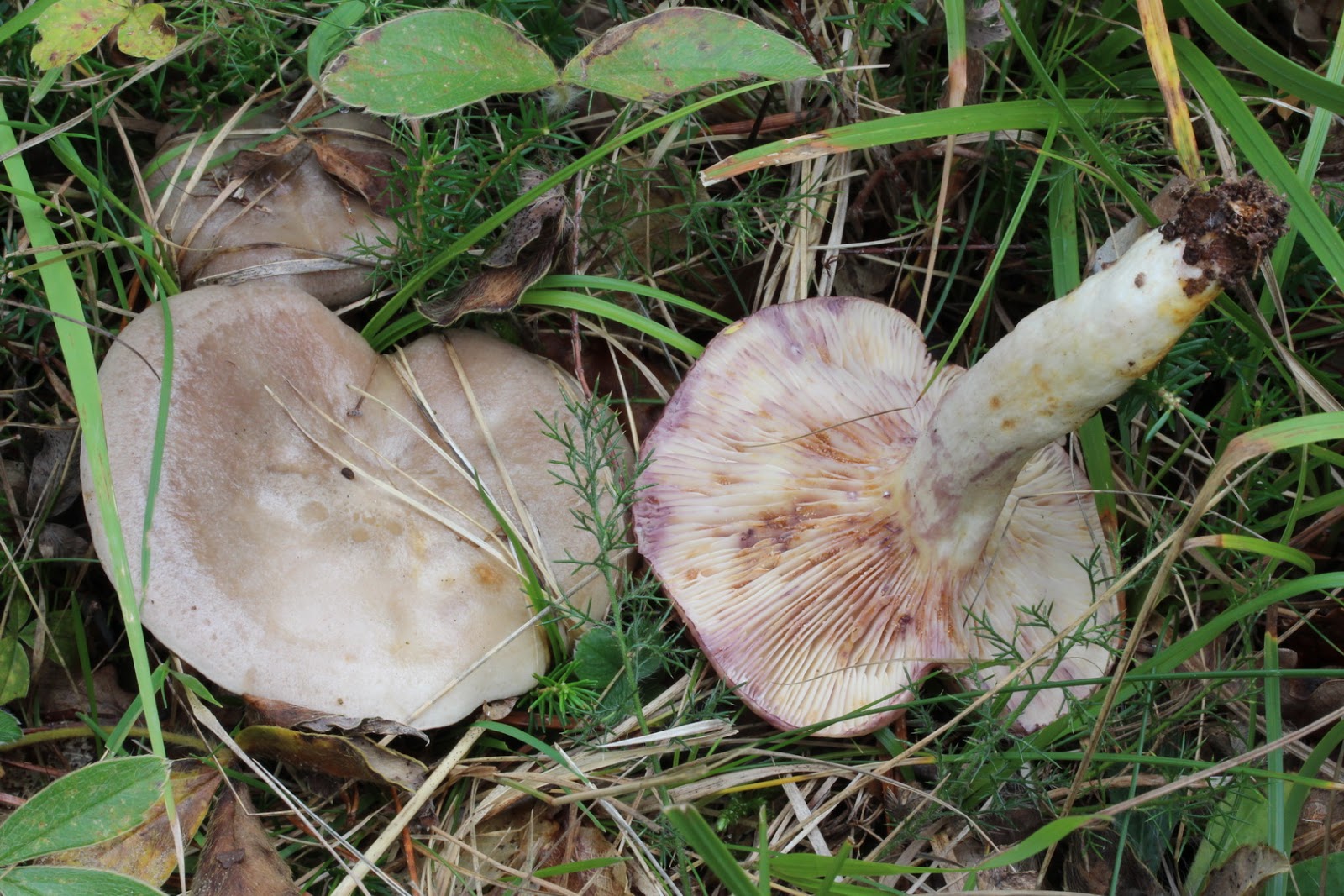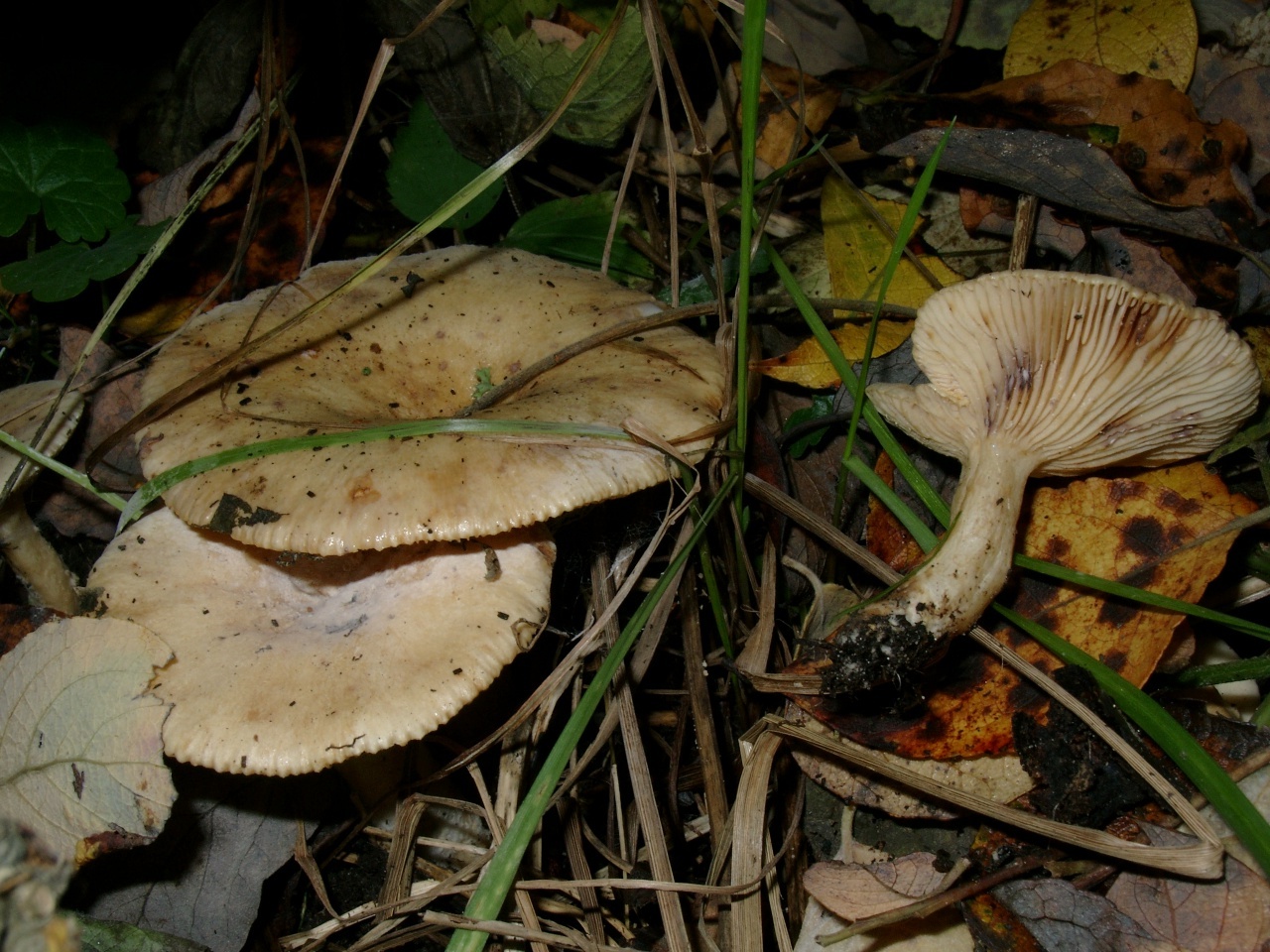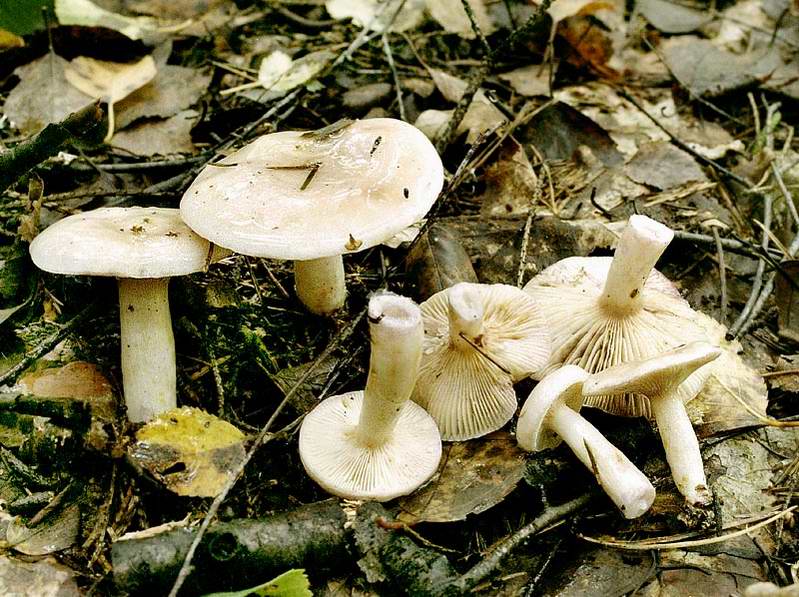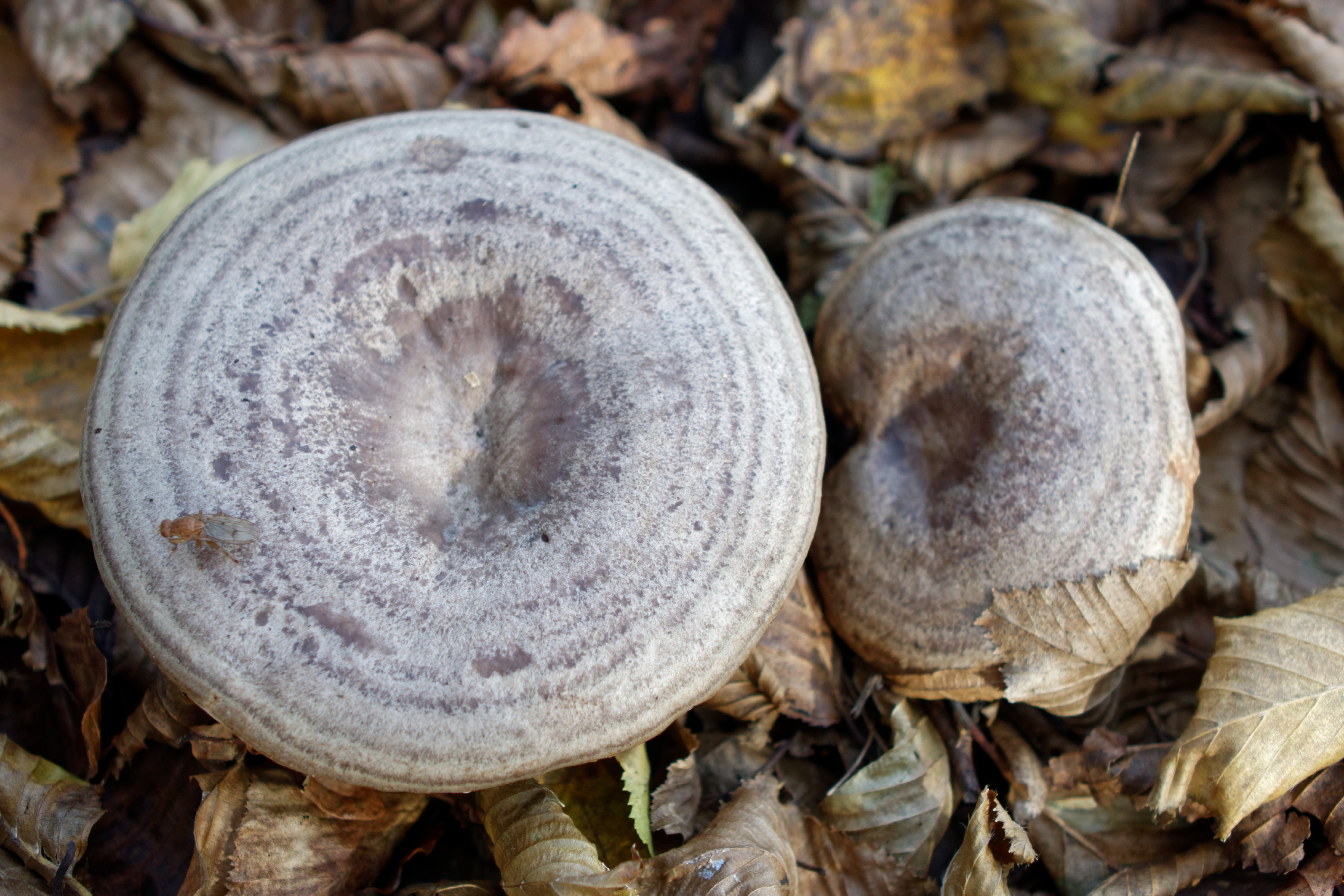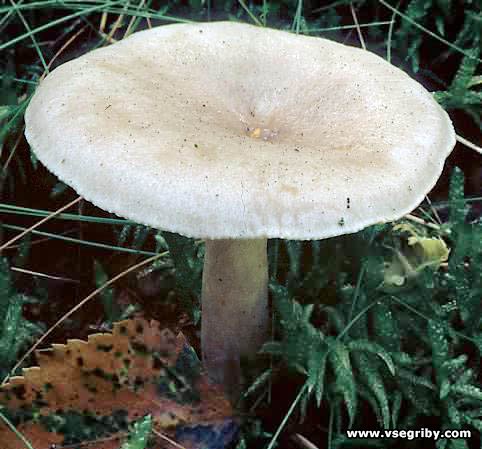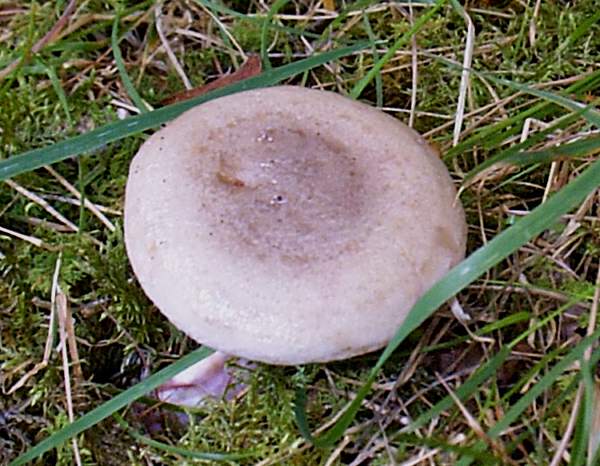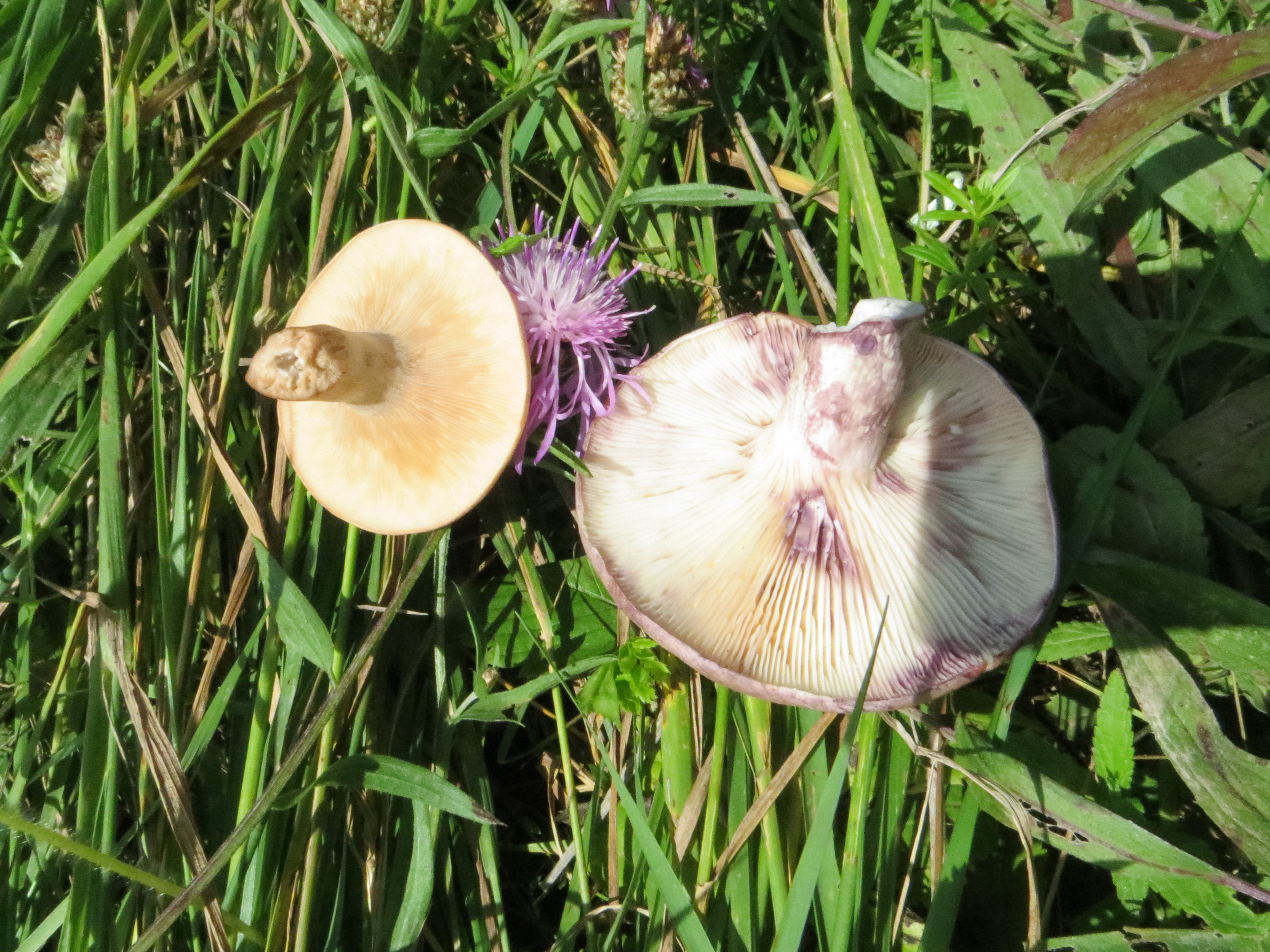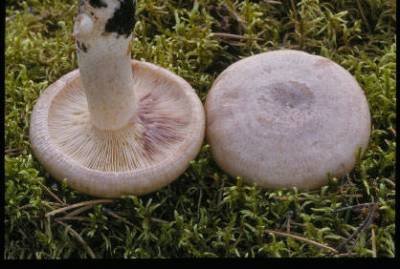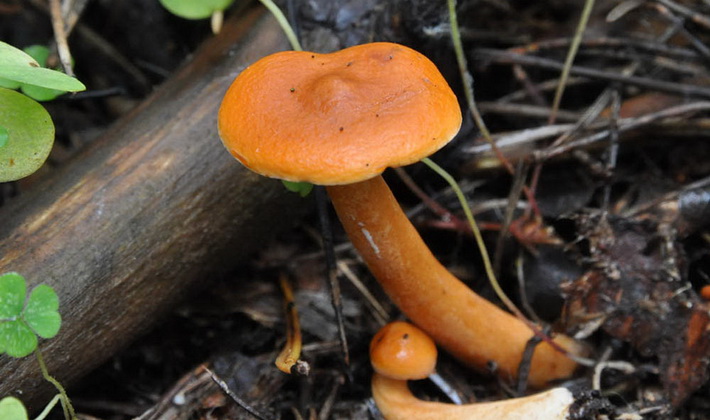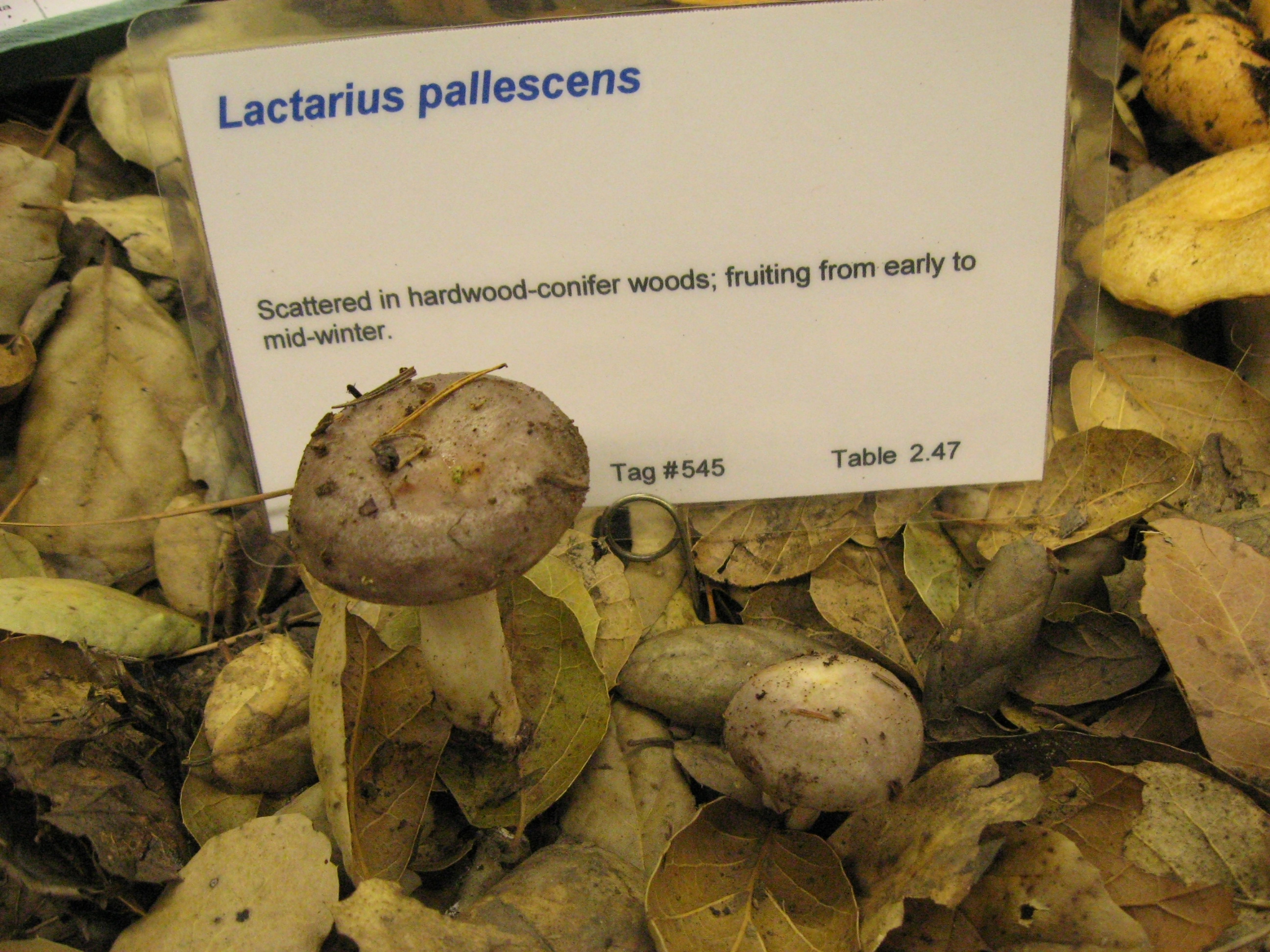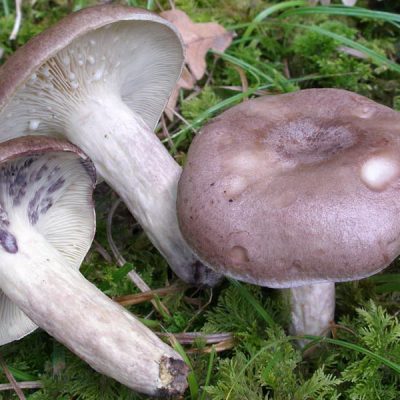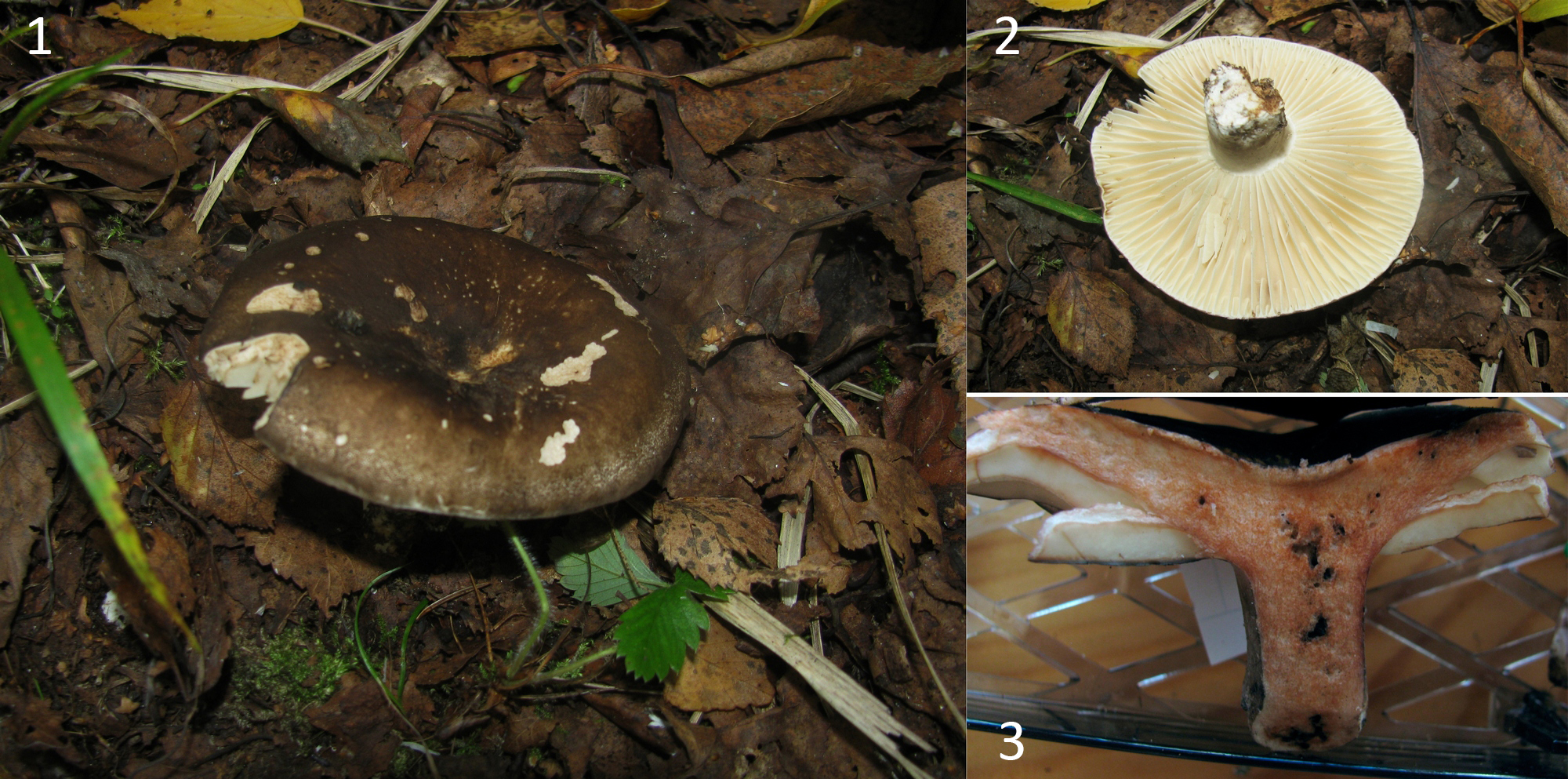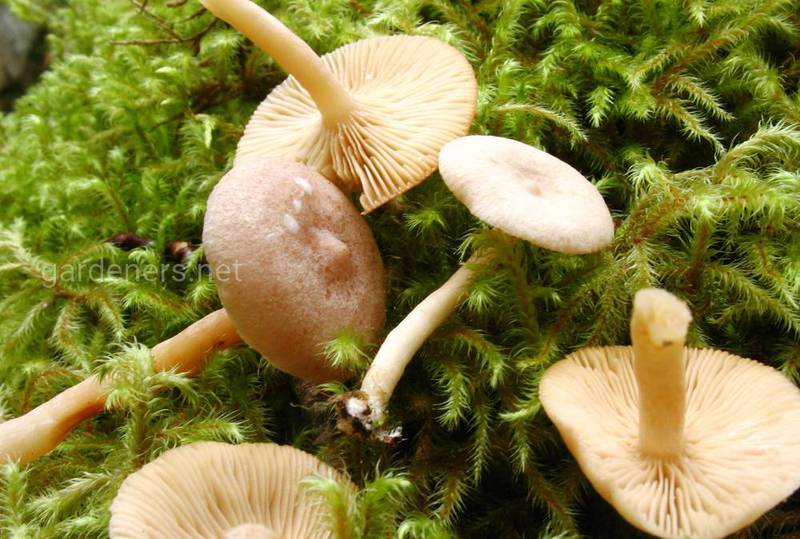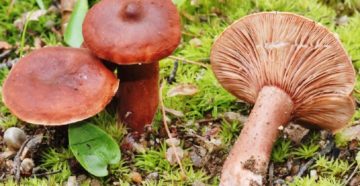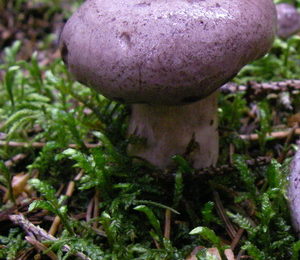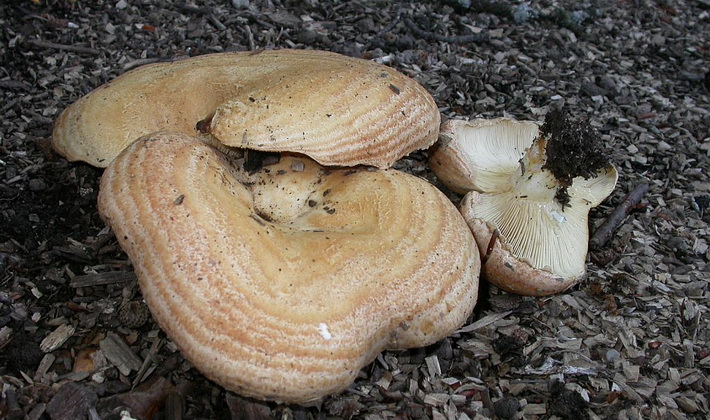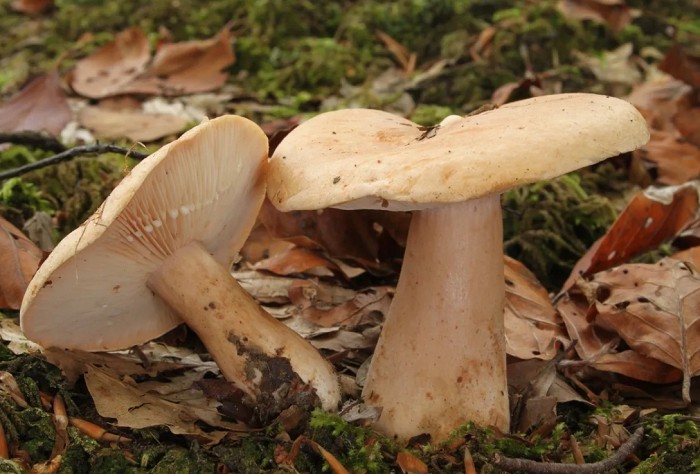External description of the mushroom
The fruiting body of a wet lactarius consists of a stem and a cap. The height of the leg is 4-7 cm, and the thickness is 1-2 cm. Its shape is cylindrical, slightly widening at the base. The structure at the foot is strong and durable, and the surface is sticky.
It is very rare to meet this type of mushroom, a distinctive feature can be called the color of the cap, which varies from grayish to gray-violet. Its diameter is 4-8 cm, in young mushrooms it has a convex shape, which becomes prostrate over time. On the surface of the cap of old, mature mushrooms, there is a depression, as well as a wide flattened tubercle. The edges of the cap are bordered with small villi and bent. From above, the cap is covered with a grayish-steel skin, with a slight shade of purple. It is wet, sticky and smooth to the touch. These characteristics are especially common in humid climates. A vaguely expressed zoning sometimes appears on the surface of the cap.
The hymenophore of the fungus is represented by plates containing white spore powder. The plates themselves have a small width, are often located, slightly descend along the stem, initially have a white color, but turn yellow over time. When pressed and damaged, purple spots appear on the plates. The milky juice of the fungus is characterized by a white color, but under the influence of air it acquires a purple hue, its release is very abundant.
The structure of the mushroom pulp is spongy and tender. It does not have a characteristic and pungent smell, but the taste of the pulp is distinguished by its sharpness. In color, the pulp of the wet lactarius is white or slightly yellowish; in case of damage to the structure of the fruiting body, a shade of purple is mixed with the main color.
Red-brown Milk (Lactarius volemus)
Synonyms:
- Galorrheus volemus
- Lactifluus volemus
- Amanita lactiflua
- Lactarius lactifluus
- Lactifluus oedematopus
- Lactarius oedematopus
- Lactarius ichoratus
- Galorrheus ichoratus
- Lactifluus ichoratus
- Lactarius testaceus
- Millechnik is the best (by the way, the official Russian-language mycological name)
- Podoreshnik (Belarusian - Padareshnik)
Lactarius volemus (Fr.) Fr., Epicr. syst. mycol. (Upsaliae): 344 (1838)
Description
A hat with a diameter of 5-17 (up to 16) cm, convex in youth, then prostrate, possibly pressed in the center, and even up to concave. The edge of the cap is straight, thin, sharp, first tucked up, then straightened and even raised. The color is reddish-brown, brownish-brown, in rare cases, rusty or light buffy. The surface is velvety at first, then smooth and dry. Often cracked, especially in dry conditions. There is no zonal coloration.
Flesh: White, yellowish, very fleshy and firm. The smell is described in various ways, mainly as a herring (trimethylamine) smell that increases with age, but there are more interesting associations, for example with pear flowers, or not at all. The taste is soft, pleasant, sweetish.
The plates are frequent, from adherent to weakly descending, creamy or warm skin shades, often forked at the leg. There are shortened plates (plates).
Milky sap is abundant, white, turning brown and thickening in the air. For this reason, this type of lactarius turns brown and everything else if damaged - pulp, plates.
The leg is 5-8 (up to 10) cm high, (1) 1.5-3 cm in diameter, hard, often full, the color of the cap, but slightly paler, smooth, may be covered with fine pubescence, which looks like frostiness, but not to the touch felt. Often tapered to the bottom.
The spore powder is white. The spores are close to spherical, according to the data 8.5-9 x 8 µm, 9-11 x 8.5-10.5 µm each. The ornamentation is ridged, up to 0.5 µm in height, forming an almost complete network.
Habitat
Occurs from July to October. One of the earliest milkmen. Grows in deciduous, mixed and spruce forests (in general, in all forests).According to the data, it forms mycorrhiza with oak (Quercus L.), common hazel (Corylus avellana L.) and spruce (Picea A. Dietr.).
Similar species
Given the "power" of this mushroom and the abundant brownish sweetish milky juice, perhaps, it has no similar species. The most similar lactic to him, perhaps, is the hygrophoroid lactarius - Lactarius hygrophoroides, but it is easily distinguished by non-brown milky juice and rare plates. Quite conditionally, rubella (Lactarius subdulcis) can be attributed to similar species, but it is thin-fleshed and slender. The same applies to the orange lactarius (Lactarius aurantiacus = L. mitissimus), it is not only small and thin, but also late, does not overlap in terms, although it grows in exactly the same biotopes with spruce.
Edibility
An edible mushroom that can be eaten raw. It is good in raw salted or pickled form, without any heat treatment. I don't like it in another form because of the "wooden" pulp, although, they say, mushroom caviar is good from it. I hunt him specifically and purposefully, for the sake of raw salting.
Literature Used 1) Verbeken, A. & Vesterholt, J. 2008. Lactarius. - In: Knudsen, H. & Vesterholt, J. (eds.): Funga Nordica, 82-107.2) Flora of Belarus. Mushrooms. In 7 volumes. Volume 1. O.S. Gapienko, Ya.A. Shaporova, 2012, Boletales. Amanitales. Russulales.
Video about the miller mushroom:
Definitioner
- Basidia (Basidia)
-
Lat. Basidia. A specialized structure of sexual reproduction in fungi, inherent only in Basidiomycetes. Basidia are terminal (end) elements of hyphae of various shapes and sizes, on which spores develop exogenously (outside).
Basidia are diverse in structure and method of attachment to hyphae.
According to the position relative to the axis of the hypha, to which they are attached, three types of basidia are distinguished:
Apical basidia are formed from the terminal cell of the hypha and are located parallel to its axis.
Pleurobasidia are formed from lateral processes and are located perpendicular to the axis of the hypha, which continues to grow and can form new processes with basidia.
Subasidia are formed from a lateral process, turned perpendicular to the axis of the hypha, which, after the formation of one basidium, stops its growth.
Based on morphology:
Holobasidia - unicellular basidia, not divided by septa (see Fig. A, D.).
Phragmobasidia are divided by transverse or vertical septa, usually into four cells (see Fig. B, C).
By type of development:
Heterobasidia consists of two parts - hypobasidia and epibasidia developing from it, with or without partitions (see Fig. C, B) (see Fig. D).
Homobasidia is not divided into hypo- and epibasidia and in all cases is considered holobasidia (Fig. A).
Basidia is the place of karyogamy, meiosis and the formation of basidiospores. Homobasidia, as a rule, is not functionally divided, and meiosis follows karyogamy in it. However, basidia can be divided into probasidia - the site of karyogamy and metabasidia - the site of meiosis. Probasidium is often a dormant spore, for example in rust fungi. In such cases, probazidia grows with metabasidia, in which meiosis occurs and on which basidiospores are formed (see Fig. E).
See Karyogamy, Meiosis, Gifa.
- Pileipellis
-
Lat. Pileipellis, skin - differentiated surface layer of the cap of agaricoid basidiomycetes. The structure of the skin in most cases differs from the inner flesh of the cap and may have a different structure. The structural features of pileipellis are often used as diagnostic features in descriptions of fungi species.
According to their structure, they are divided into four main types: cutis, trichoderma, hymeniderma and epithelium.
See Agaricoid fungi, Basidiomycete, Cutis, Trichoderma, Gimeniderm, Epithelium.
- Anastomoses (Anastomosis)
-
1) Fusion of cells of branched hyphae or germ tubes of germinating spores;
2) Connecting the plates of the fruiting bodies of the mushrooms with jumpers.
Orange milky mushroom and its photo
Category: conditionally edible.
Orange lactarius cap (Lactarius mitissimus) (diameter 4-12 cm): usually orange or deep apricot color, very thin.In young mushrooms, it is slightly convex or flat, over time it changes to funnel-shaped.
Leg (height 3-11 cm): cylindrical, one color with a cap. In young mushrooms it is dense, often becomes hollow over time.
Plates: not very frequent, cream colored.

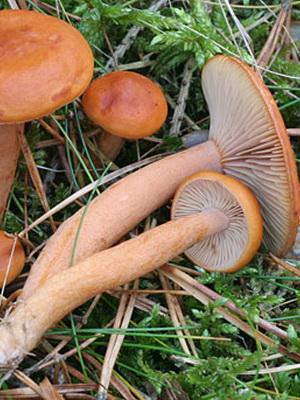
If you look closely at the photo of the orange milkman, you can see bright red spots on its plates.
Flesh: firm, usually light orange. Does not have a pronounced smell and taste.
Doubles: young brownish lactarius (Lactarius fuliginosus), but it has a darker cap color and a long stem.
When it grows: from mid-July to early October in temperate countries of the Eurasian continent.
Where can you find it: The non-caustic miller is found by mushroom pickers in forests of various types, usually next to oaks, spruces and birches. It can bury itself very deeply in moss litter.
Eating: usually salted or pickled.
Application in traditional medicine: not applicable.
Other names: non-caustic milkman.
Places of growth of stunted milkmen.
Gentle milkmen settle on mossy surfaces. You can find them in damp and humid places. Stunted milkmen grow in mixed and deciduous forests. The species begins to bear fruit in July, this process continues until September.
Evaluation of the edibility of stunted milkmen.
These conditionally edible mushrooms do not have excellent taste, but they are quite good when salted.

Millers are not in great demand among mushroom pickers due to the fact that they are bitter and require lengthy preparation. But when cooked properly, they taste good. Miller stunted should be soaked in water for several days. The water should be salted and cool. The water must be drained periodically. Soaking allows you to get rid of the bitter milky juice, the pulp itself tastes without bitterness. After that, the mushrooms are boiled for a short time - about 7 minutes. And then they can be salted.
Similar species.
Little reddish or sweetish lactarius bears resemblance to a stunted lactarius. It can be recognized by the milky juice, which remains unchanged in the air. The sweetish lactarius is also a conditionally edible mushroom. His hat is reddish-red, with rolled-up edges and a smooth surface. The leg is slightly lighter. Milky juice is abundant enough.

Rubella grows in different forests. You can find them among the moss deposits. They are collected from summer to autumn.
Bitter or bitter milkman also has an outward resemblance to a stunted milkman. It is also a conditionally edible mushroom. The shape of its cap is first bell-shaped, and then depressed. The skin of the cap is reddish-brown in color, and light towards the edges. The pulp is brittle, but tough, with a peppery flavor. Milky juice is sharp, white, does not change color. The stem is cylindrical, reddish, matte, with a whitish downy.

Bitters grow under conifers and birches. They settle most often on acidic soils. These mushrooms grow in many regions and are the most common representative of the genus. Fruiting occurs in summer and autumn.
Miller pink-gray
| Group: | Lamellar |
| Plates: | White, beige-gray-pink |
| Colour: | Beige-gray-pink |
| Info: | Smells like chicory at the break |
| Department: | Basidiomycota (Basidiomycetes) |
| Subdivision: | Agaricomycotina (Agaricomycetes) |
| Class: | Agaricomycetes (Agaricomycetes) |
| Subclass: | Incertae sedis (indefinite) |
| Order: | Russulales |
| Family: | Russulaceae (russula) |
| Genus: | Lactarius (Miller) |
| View: | Lactarius helvus (Gray-pink Miller) |
According to some sources, this type of milkmen is inedible, and according to others, it is conditionally edible. In foreign literature it is noted as weakly poisonous; in the domestic one - as inedible or as edible, but of little value due to a sharp unpleasant odor.
Hat
Grows to medium size (up to about 15 cm in diameter). In the middle of it, both an impression and a tuberous outgrowth can form. With the growth of the fungus, both signs appear at the same time. The edges of the cap in young mushrooms are rolled downwards, and open upwards with age.Its color is beige-gray-pink. The surface is non-slimy, dry and velvety to the touch.
Pulp
Fleshy, pale and rather fragile. When broken or cut, the pulp smells very strongly of chicory. It tastes bitter. It emits a small amount of milky juice, which resembles water in consistency. The juice does not change color when exposed to air.
Leg
The legs of these milkmen are short and very stocky (approximately 8 * 2). Their color is slightly lighter than the surface of the cap. In young specimens, the legs are full, and in the process of growth they form irregular cavities inside. These milkmen do not have any additional growths on the legs, they are smooth.
Spore-bearing layer
The spore layer is made of plates. Plates of medium thickness and frequency. Almost the same color as the hat, but a little lighter. In very young mushrooms, the plates are almost white, then darken.
Spore powder
The spores of the gray-pink lactarius are almost round, of medium size, with a reticular surface, the bulk of the powder is orange-yellow.
Distribution and collection
The gray-pink miller is distributed throughout the northern hemisphere in a temperate climate. Usually it forms mycorrhiza with conifers such as pine or spruce, but in other conditions it can grow next to deciduous ones, in particular, with birch. This species prefers acidified soils, which are usually found in thickets of blueberries and near swamps.
Similar species
This type of milkman has practically no twins due to its extremely specific smell.
But outwardly, it may look like:
It features an implicit concentric pattern on the head. In addition, the smell is different - the oak milkman smells like hay, not chicory. In general, this mushroom is smaller and grows mainly near oak trees.
This mushroom is also distinguished by a more modest size and a darker color, predominantly brownish-red. Doesn't smell like chicory like the gray-pink variety.
How to cook milk mushrooms correctly?
Mushrooms of the milky genus can be eaten fried, boiled, pickled, but in this form, their taste is lost. They are ideal in fermented and salted form. The mushrooms are good salted without prolonged soaking, boiling and spices. Waves, milk mushrooms, lactarius and bitters, on the contrary, are pre-soaked and / or boiled and salted with herbs and roots. Bitterness-free millers can be dried.
It is better to start processing mushrooms immediately after returning home. If for some reason you have to postpone the processing time, then you need to shake off the mushrooms from forest debris, put them in paper bags unwashed and put them in the vegetable section of the refrigerator. But even in this form, they cannot be stored for more than one and a half days, the optimal period is 6-8 hours. During preparation for salting, they are washed, cleaned, but the skin is not removed from them.
Soaked milk mushrooms, volushki, bitters, whites and other milkers to remove bitterness from them. The procedure is carried out from several hours to 10 days, with regular water changes. In the north and central part of Russia, milk mushrooms, mushrooms, whites and volnushki are soaked for 3 days, bitters - from 3 to 10 days. In Belarus, mushrooms are soaked for 2-4 hours, whites - 1 day, milk mushrooms - 2 days. In the Volga region, these mushrooms are not soaked at all. Especially bitter milk-lovers, such as pepper milk mushrooms and bitters, after soaking before salting, are best boiled for 15 minutes in salted water and cooled.
There are many ways to prepare salted milkmen. In the Urals and Siberia, many people use the following method of salting real mushrooms: they are poured with cold spring water, quickly washed, freeing them from forest debris, earth and damage. Lay in layers in tubs, salt at the rate of 30-40 g of salt per 1 kg of mushrooms. The tubs are placed in a cellar, where, at a constant temperature, the mushrooms are salted after 45-60 days. Milk mushrooms prepared in this way are tasty and crispy and are well protected until next summer. The mushrooms salted in this way are ready to eat in 7 days.

Ginger is real. Photo by: Josep Xicota, CC BY-SA 3.0
Characteristics of the milky mushroom
Hat
- Advertising -
The average diameter of the lactic cap reaches 8 cm, but there are specimens with caps up to 30-40 cm in diameter. In young mushrooms, the edge of the cap adjoins the stem, gradually it straightens out to a flat, flat-concave or funnel-shaped shape. Sometimes a tubercle is expressed in the center. The edge is even, less often wavy. The color of the caps in different types of milkweed varies from white, gray, yellow, orange, brown to blue, purple, pink and even olive black. The color can also change with the age of the fungus. The surface of the cap is also variable: from smooth or velvety to scaly or pubescent.
Pulp
The fresh pulp of the lactarius has a pungent, pungent taste, or, on the contrary, fresh or slightly spicy, sometimes sweetish. The color of the flesh is usually white with a brown, gray, fawn or cream shade. The pulp changes color at cut and with age. Her smell is weak and vague, sometimes absent, specific only for certain species.
Leg
- Advertising -
The leg is cylindrical, narrows or expands to the base, the shape is club-shaped or swollen; the color matches the hat. Leg diameter 1.5-2 cm, height 5-8 cm. The surface is dry and smooth, sometimes sticky or slimy. Gradually, the leg becomes spongy and hollow.
Harm and contraindications of milkmen
You must not pick and eat mushrooms that grow next to highways, garbage cans and factories that pollute the environment. The fact is that any mushrooms absorb harmful substances and heavy metals. Accordingly, they can be harmful to health.
Conditionally edible milkmen cannot be eaten without preliminary processing - soaking, boiling
This is done to remove the bitter milky juice, which, if it enters the human digestive system, can cause eating disorders.
All mushrooms should be eaten in small quantities, and with diseases such as pancreatitis, stomach and duodenal ulcers, gastritis, liver failure, cirrhosis of the liver, hepatitis, they should be abandoned altogether.
Lacticians are eaten with caution during pregnancy and lactation. Mushrooms are contraindicated for small children.
Salted mushrooms should not be eaten with hypertension and kidney disease, as this threatens to disrupt the water-salt balance.
The gingerbreads are real.
External description of the mushroom
Mayor's Miller (Lactarius mairei) is a classic fruiting body, consisting of a cap and a leg. The fungus is characterized by a lamellar hymenophore, and the plates in it are often located, grow to the stem or descend along it, have a cream color, and are highly branched.
The pulp of the lactician Mayor is characterized by medium density, whitish color, burning aftertaste that appears shortly after eating the mushroom. The milky juice of the mushroom also tastes hot, does not change its color under the influence of air, the aroma of the pulp is similar to that of a fruit.
The cap of the Milky Mayor is characterized by a curved edge in young mushrooms (it straightens out as the plant reaches maturity), a depressed central part, a smooth and dry surface (although in some mushrooms it may feel like felt). A fluff runs along the edge of the cap, consisting of hairs of small length (up to 5 mm), resembling needles or thorns. The color of the cap varies from light cream to clay-cream, and spherical areas emanate from the central part, painted in a pinkish or saturated clay. Such shades reach about half the diameter of the cap, the size of which is 2.5-12 cm.
The length of the mushroom leg is 1.5-4 cm, and the thickness varies within 0.6-1.5 cm. The shape of the leg resembles a cylinder, and to the touch it is smooth, dry, and does not have the slightest dent on the surface. In immature mushrooms, the leg is filled inside, and as it ripens, it becomes empty. It is characterized by pink-cream, cream-yellow or cream color.
Fungal spores have an ellipsoidal or spherical shape, with ridged areas visible on them. The spore sizes are 5.9-9.0 * 4.8-7.0 microns. The color of the spores is predominantly cream.


